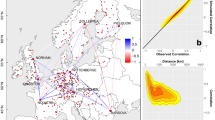Abstract
According to the fact that the traditional mathematical statistical model can hardly analyze flood risk issues when the sample size is small, this paper puts forward a model based on information diffusion method. Taking Henan province for example, the risks of different flood grades are obtained. Results show that by using this risk analysis method we can avoid the problem of inaccuracy faults by small sample size, the estimations obtained by this risk method conform with the actual disasters and the method is satisfactory.
Access this chapter
Tax calculation will be finalised at checkout
Purchases are for personal use only
Preview
Unable to display preview. Download preview PDF.
Similar content being viewed by others
References
Huang, C.F.: Integration degree of risk in terms of scene and application. Stochastic Environmental Research and Risk Assessment 23(4), 473–484 (2009)
Huang, C.F.: Information diffusion techniques and small-sample problem. Internat. J. Information Technol. Decision Making 1(2), 229–249 (2002)
Huang, C.F.: Risk Assessment of Natural Disaster: Theory & Practice, pp. 86–98. Science Press, Beijing (2005)
Huang, C.F., Shi, Y.: Towards Efficient Fuzzy Information Processing-Using the Principle of Information Diffusion. Physica-Verlag (Springer), Heidelberg, Germany (2002)
Jin, J.L., Zhang, X.L., Ding, J.: Projection Pursuit Model for Evaluating Grade of Flood Disaster Loss. Systems Engineering-theory & Practice 22(2), 140–144 (2002)
Chen, S.Y.: Theory and model of variable fuzzy sets and its application. Dalian University of Technology Press, Dalian (2009)
Chen, S.Y.: Fuzzy recognition theory and application for complex water resources system optimization. Jilin University Press, Changchun (2002)
Chen, S.Y.: Theory and model of engineering variable fuzzy sets - mathematical basis for fuzzy hydrology and water resources. Journal of Dalian University of Technology 45(2), 308–312 (2005)
Jin, J.L., Jin, B.M., Yang, X.H., Ding, J.: A practical scheme for establishing grade model of flood disaster loss. Journal of Catastrophology 15(2), 1–6 (2000)
Author information
Authors and Affiliations
Editor information
Editors and Affiliations
Rights and permissions
Copyright information
© 2011 Springer-Verlag Berlin Heidelberg
About this paper
Cite this paper
Qiong, L. (2011). Flood Risk Assessment Based on the Information Diffusion Method. In: Lin, S., Huang, X. (eds) Advances in Computer Science, Environment, Ecoinformatics, and Education. CSEE 2011. Communications in Computer and Information Science, vol 214. Springer, Berlin, Heidelberg. https://doi.org/10.1007/978-3-642-23321-0_17
Download citation
DOI: https://doi.org/10.1007/978-3-642-23321-0_17
Publisher Name: Springer, Berlin, Heidelberg
Print ISBN: 978-3-642-23320-3
Online ISBN: 978-3-642-23321-0
eBook Packages: Computer ScienceComputer Science (R0)




